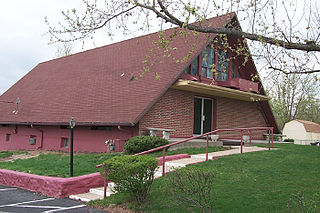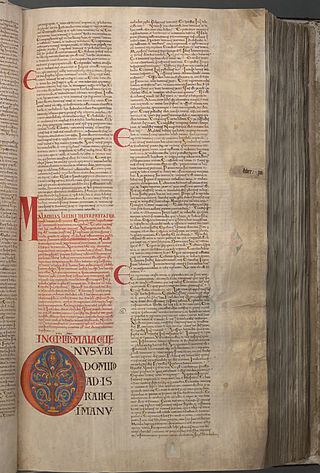
The Standard Works of the Church of Jesus Christ of Latter-day Saints are the four books that currently constitute its open scriptural canon. The four books of the standard works are:

In religion, a prophet or prophetess is an individual who is regarded as being in contact with a divine being and is said to speak on behalf of that being, serving as an intermediary with humanity by delivering messages or teachings from the supernatural source to other people. The message that the prophet conveys is called a prophecy.

In religion, a prophecy is a message that has been communicated to a person by a supernatural entity. Prophecies are a feature of many cultures and belief systems and usually contain divine will or law, or preternatural knowledge, for example of future events. They can be revealed to the prophet in various ways depending on the religion and the story, such as visions, divination, or direct interaction with divine beings in physical form. Stories of prophetic deeds sometimes receive considerable attention and some have been known to survive for centuries through oral tradition or as religious texts.
In the Latter Day Saint movement, priesthood is the power and authority of God given to man, including the authority to perform ordinances and to act as a leader in the church. A group of priesthood holders is referred to as a quorum.

The Church of Christ, informally called Hedrickites and the Church of Christ , is a denomination of the Latter Day Saint movement headquartered in Independence, Missouri, on what is known as the Temple Lot. The nickname for members of the church comes from the surname of Granville Hedrick, who was ordained as the church's leader in July 1863. Unlike the Church of Jesus Christ of Latter-day Saints and Community of Christ, the Temple Lot church rejects the office of prophet or president, being instead led by its Quorum of Twelve Apostles. The church also rejects the doctrines of baptism for the dead and celestial marriage promulgated by the Utah-based LDS Church, as well as the Doctrine and Covenants and Pearl of Great Price. While once avidly engaged in dialogue with other Latter Day Saint factions, the church no longer has any official contact with any other organization. It is notable for its sole ownership of the Temple Lot, which it has held for nearly 150 years. As of 2013, membership is 7,310 members in 11 countries. Most of the members live in the United States, but there are parishes in Canada, Mexico, Honduras, Nigeria, Kenya, Democratic Republic of the Congo, Malawi, Tanzania, India, and the Philippines.
Church of Christ may refer to:

The Church of Christ with the Elijah Message is the name of three related church groups and a denomination of the Latter Day Saint movement, headquartered in Independence, Missouri. It split from the Church of Christ in 1943 in a dispute over claimed revelations given to its founder William A. Draves. Draves, an elder in the Fettingite group, claimed to be receiving messages from an angelic being who identified himself as John the Baptist—the same person who had allegedly appeared to Fettingite founder Otto Fetting, a former apostle of the Temple Lot Church of Christ. While many Fettingites accepted these new missives, some did not, leading Draves to form his own church. His adherents claim it to be the sole legitimate continuation of Fetting's organization, as well as that of the Temple Lot church. As of 1987, the church had approximately 12,500 adherents spread between Africa, Europe, Asia, Australia and the Americas.

The Latter Day Saint movement is a religious movement within Christianity that arose during the Second Great Awakening in the early 19th century and that led to the set of doctrines, practices, and cultures called Mormonism, and to the existence of numerous Latter Day Saint churches. Its history is characterized by intense controversy and persecution in reaction to some of the movement's doctrines and practices and their relationship to mainstream Christianity. The purpose of this article is to give an overview of the different groups, beliefs, and denominations that began with the influence of Joseph Smith.

Otto Fetting was an American realtor and editor from Port Huron, Michigan who served first as a pastor and evangelist in the Reorganized Church of Jesus Christ of Latter Day Saints, and then later as an apostle in the Church of Christ, commonly referred to as the "Hedrickites". Fetting claimed to have been visited by John the Baptist thirty or more times between February 4, 1927 and his death on January 30, 1933. Fetting was reportedly given instruction concerning the doctrine and practices of Hedrickites and other factions of Christianity, together with directives to begin construction of a temple on the Temple Lot, including its exact dimensions.

In the Latter Day Saint movement, a temple is a building dedicated to be a house of God and is reserved for special forms of worship. A temple differs from a church meetinghouse, which is used for weekly worship services. Temples have been a significant part of the Latter Day Saint movement since early in its inception. Today, temples are operated by several Latter Day Saint denominations. The most prolific builder of temples of the Latter Day Saint movement is the Church of Jesus Christ of Latter-day Saints. There are 175 dedicated temples (171 currently operating; 4 previously dedicated, but closed for renovation; 55 under construction; and 70 announced, for a total of 300. Several others within the movement have built, or attempted to build, temples. The Community of Christ operates two temples in the United States, which are open to the public and are used for worship services, performances, and religious education. Other denominations with temples are the Apostolic United Brethren, the Church of Christ, the Fundamentalist Church of Jesus Christ of Latter-Day Saints and the Righteous Branch of the Church of Jesus Christ of Latter-day Saints.
Within the Latter Day Saint movement, the "Articles of Faith" is a statement of beliefs composed by Joseph Smith as part of an 1842 letter sent to "Long" John Wentworth, editor of the Chicago Democrat, and first published in the Latter Day Saint newspaper Times and Seasons. It is a concise listing of thirteen fundamental doctrines of Mormonism. Most Latter Day Saint denominations view the articles as an authoritative statement of basic theology. Some denominations, such as the Church of Jesus Christ of Latter-day Saints, have adopted the articles as scripture. For some sects, the Articles of Faith are known collectively as "An Epitome of Faith and Doctrine".
In Mormonism, revelation is communication from God to man. Latter Day Saints teach that the Latter Day Saint movement began with a revelation from God, which began a process of restoring the gospel of Jesus Christ to the earth. Latter Day Saints also teach that revelation is the foundation of the church established by Jesus Christ and that it remains an essential element of his true church today. Continuous revelation provides individual Latter Day Saints with a "testimony", described by Richard Bushman as "one of the most potent words in the Mormon lexicon".

The Temple Lot, located in Independence, Missouri, is the first site to be dedicated for the construction of a temple in the Latter Day Saint movement. The area was dedicated on August 3, 1831, by the movement's founder, Joseph Smith Jr., and purchased on December 19, 1831, by his colleague Edward Partridge to be the center of the New Jerusalem or "City of Zion" after he received a revelation stating that it would be the gathering spot of the Latter Day Saints during the last days.
Church of Christ at Halley's Bluff is a small denomination within the Latter Day Saint movement. It was formed in 1932 by former members of the Church of Christ, and in 1972 it lost most of its members to the leadership of Dan Gayman, who left the church and established the Church of Israel.

The Church of Christ, informally referred to as the Fettingites, is a denomination within the Latter Day Saint movement which split from the Church of Christ—informally known as "Hedrickites"— in late 1929. The faction was formally established on April 8, 1930, and an Associated Press report published in The New York Times and Los Angeles Times April 7, 1930, describes it as having been briefly named "The Church of Jesus Christ" and later, the "Church of Christ". It is informally referred to as the "Church of Christ (Fettingite)", after its founder, Otto Fetting, but this sect has never officially been named as such. Otto Fetting, an Apostle in the Church of Christ, was the alleged recipient of a series of messages delivered by John the Baptist concerning construction of a temple on the Temple Lot, along with other aspects of Hedrickite doctrine and practice. The rejection of his "Twelfth Message" by a majority vote of his fellow Apostles in October 1929 led to a split in the Temple Lot organization between those who rejected Fetting's messages and those who accepted them. The "Fettingites" subsequently established their own church organization.

The Church of Christ (Restored) is a denomination within the Latter Day Saint movement that split from the Church of Christ (Fettingite) in the late 1930s under the leadership of Elder A. C. DeWolf. This schism was provoked by a difference in opinion regarding a series of claimed "messages" received by William Draves, an elder in that church, following the death of founder Otto Fetting. Whereas the main Fettingite church initially chose to grant cautious acceptance to these missives, several Fettingite branches in Louisiana and Mississippi did not, and split from the main organization to form the Church of Christ (Restored). Even after the main Fettingite church chose to reject Draves and his messages in 1943, the DeWolf faction refused to reconcile with the main body, considering itself to be the sole legitimate continuation of the Fettingite church, and the only true church on earth today. Its membership is currently concentrated mostly in the American South, and stands at about 450 members.

Revelation 1 is the first chapter of the Book of Revelation or the Apocalypse of John in the New Testament of the Christian Bible. The book is traditionally attributed to John the Apostle, but the precise identity of the author is a point of academic debate. This chapter contains the prologue of the book, followed by the vision and commission of John.

The Church of Christ with the Elijah Message - The Assured Way of the Lord, Inc., informally called The Assured Way, is a denomination of the Latter Day Saint movement based in Independence, Missouri. The Assured Way church is one of four groups that trace their origin to the church founded by William Draves in 1943, after his split with Otto Fetting, who had founded the Church of Christ. Although all four churches have similar names and nearly identical doctrines, they are not in communion and maintain separate legal organizations. The Assured Way church was legally incorporated by William Draves' son, Leonard Draves in 2004, six months after Leonard was removed from the ministry by other leaders of the Church of Christ with the Elijah Message, Inc. Leonard Draves had previously founded the Church of Christ with the Elijah Message, Inc., after breaking with the Church of Christ with the Elijah Message, Established Anew 1929.

Malachi 4 is the fourth chapter of the Book of Malachi in the Hebrew Bible or the final chapter in the Old Testament of the Christian Bible. This book contains the prophecies attributed to the prophet Malachi, and is a part of the Book of the Twelve Minor Prophets.













